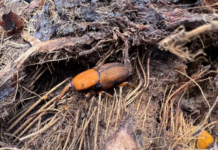Plant breeders in Uganda and Tanzania have developed drought-tolerant and disease-resistant banana hybrids that are intended to support the commercialization of East Africa’s banana sector.
Dr. Ivan Kabiita Arinaitwe of Uganda’s National Banana Research Program confirmed the report and explained that the high- yielding new hybrids were developed through conventional breeding by crossing an East African highland banana cultivar (Triploid 3x) and a male diploid (2x) parent of the wild species Musa acuminata, which contributes the source of resistance to pests and diseases.
The new hybrids are resistant to black Sigatoka (Mycosphaerella fijiensis), a serious plant disease first reported in Tanzania in 1987 and in Uganda in 1990. Black Sigatoka, also known as leaf spot disease, is the most serious constraint to banana production in the Great Lakes region. Recent research indicates the disease causes the premature ripening of the fruit, reducing yields by 76%.
Increase yields
In addition to disease-resistance, the new hybrids are better adapted to drought and have more leaf cover. They also increase yields four-fold and taste much like popular local varieties, making them well-suited to long-lasting plantations and improving food security, researchers said.
“Up to 90 hectares of banana breeding fields have as a result been planted at the [NARO] research laboratories in Kawanda, near Kampala,” Arinaitwe said. “In the laboratories, pollinations and evaluations of banana bunches are done to get hybrid seeds from which improved primary hybrids are obtained. The first level hybrids generated from the primary pollinations are then crossed with improved diploids (2x) to create secondary triploids (3x) from which final hybrids with desired traits are evaluated and picked,” said Dr. Ivan.
The achievements realized under the auspices of the Accelerated Breeding Better Banana Initiative (ABBB), the world’s biggest banana breeding program, bode well for the region, which recently approved field trials for genetically modified BXW-resistant bananas.
Field trials
Kenya’s National Biosafety Authority approved field trials for the BXW-resistant GM bananas at the end of 2017. The Authority’s website indicates that the trials are still ongoing. By all accounts, the development of a GM crop in Kenya takes between 10-12 years from laboratory experiment to full commercialization.
The response to the new hybrids has also been positive from more than 1,350 Ugandan and Tanzania smallholder banana farmers who have struggled to sustain their plantations beyond four or five years in the face of intense pressure from plant diseases like Xanthomonas wilt (BXW), fusarium wilt and black Sigatoka, noted Dr. Jerome Kubiriba, a researcher at Uganda’s National Agriculture Research Organization (NARO).
Some regional agricultural analysts predict that East Africa’s banana farmers will soon enjoy the best of both worlds: bananas developed from conventional breeding and emerging biotechnologies like genome editing. The new advances also mean it’s highly likely that the region will be able to control the devastating Xanthomonas wilt (BXW) disease that has stymied production.








